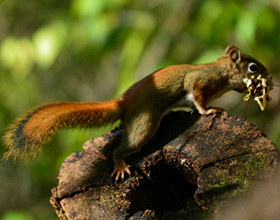 Squirrels are among the most recognizable local wildlife; they’re noisy, they’re active, and they always seem to be around. But there’s more than one way to be a squirrel! Squirrels are members of the rodent family Sciuridae, and our local parks are home to several species within that group, including the bushy-tailed tree squirrels (gray, red, and fox species), mischievous eastern chipmunks, nocturnal northern flying squirrels, and stocky woodchucks of Groundhog Day fame. During summer, the day-active members of this group are conspicuous. But now, with winter upon us, chipmunks and, especially, woodchucks have gone missing. They’re still here, though; they’re just hiding for a few months, dormant in their underground nests.
Squirrels are among the most recognizable local wildlife; they’re noisy, they’re active, and they always seem to be around. But there’s more than one way to be a squirrel! Squirrels are members of the rodent family Sciuridae, and our local parks are home to several species within that group, including the bushy-tailed tree squirrels (gray, red, and fox species), mischievous eastern chipmunks, nocturnal northern flying squirrels, and stocky woodchucks of Groundhog Day fame. During summer, the day-active members of this group are conspicuous. But now, with winter upon us, chipmunks and, especially, woodchucks have gone missing. They’re still here, though; they’re just hiding for a few months, dormant in their underground nests.
The challenge for any mammal in winter is to maintain energy balance. Mammals are endothermic, meaning they generate enough heat from their own metabolism to maintain a warm body temperature. Like us, an active squirrel at any time of year has a body temperature of about 37 degrees Celsius (95 – 100 oF). As the outside temperature cools, the animal loses more heat to the environment, and so it must generate more heat to stay warm. In general, staying warm is more of a challenge for a smaller animal, which has a larger surface area (loses more heat) relative to its body mass. And so, as the colder seasons advance, small mammals must have strategies to match their energy expenditure to available resources.
One strategy to accomplish that balance is to sustain a warm body temperature throughout winter, at the cost of high energy expenditure. Tree squirrels and flying squirrels employ this strategy. In part, they use behaviors to reduce heat loss, including building insulated shelters and, particularly for flying squirrels, huddling in groups. But even with those behaviors, winter-active squirrels require adequate food resources to fuel their metabolism. These squirrels don’t store much extra fat, maybe 10% or less of body mass. Instead, they survive by caching food in advance of winter. Whereas red squirrels create a single large collection of seeds, gray squirrels may bury as many as 10,000 nuts and seeds in up to 1,000 different sites. Then, they have an incredible ability to find those stashed resources during winter. (Those left unretrieved help to reseed the forest.)
In contrast, both the smallest of our squirrels (chipmunks) and the largest (woodchucks) use a different winter strategy. That is, they (partially) give up on staying warm during cold weather and instead hibernate, dropping body temperature toward environmental temperature. Energy expenditure declines by a factor of 2 – 3 for each 10oC drop in body temperature, so a hibernating mammal conserves its fuel stores by burning energy at 5% or less of the rate when it’s warm-bodied. Some hibernating mammals support their winter metabolism from stored fat; woodchucks may double their body mass with fat before winter, then cease eating for the next several months. In contrast, chipmunks gain a little fat but mostly store food in their burrows during autumn, then arouse to eat at intervals during hibernation. They may even emerge aboveground if food is abundant.
Hibernation entails major resets to the body’s regulatory systems. As a woodchuck reduces its body temperature from “normal” (37oC) to hypothermic (7oC or so at a burrow temperature of 5oC), heart rate drops from 100 to 1 or 2 beats per minute. Breathing rate may be reduced to 10% and blood pressure to one-third of normal values. In hibernators that stop feeding, the intestinal tract undergoes substantial reduction in size and function. However, despite long spells of inactivity, hibernators seem not to suffer loss of bone or muscle strength.
Hibernation is not a simple on/off phenomenon. During a hibernation season lasting several months, the animal alternates between bouts of hibernation (each lasting 15 – 20 hours in chipmunks, ~150 hrs in woodchucks) and arousals back to normal body temperature (for ~15 hrs in chipmunks, 35 hrs in woodchucks). Overall, depending on species and conditions, 10 – 50%, of the hibernation season is spent at normal body temperature. Those arousal bouts may provide the opportunity to eliminate metabolic wastes, to eat (in some species), and to check on environmental conditions.
The diversity of winter strategies within a group of related species is fascinating, and it offers a framework for research. Studies of sciurid rodents might help us understand the underlying mechanisms behind regulation of metabolism and fattening, support of bone and muscle strength, the ability to induce prolonged sleep, the workings of memory, and other topics of biomedical interest. And while we contemplate those heady topics—squirrels are always a good source of entertainment, too!
